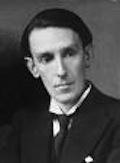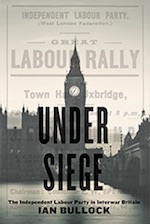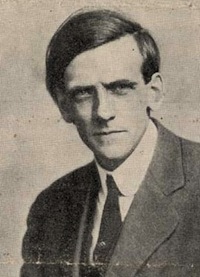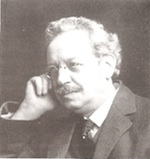IAN BULLOCK assesses the record of the ILP between the wars and seeks to draw a few lessons for Labour and the left today
First, I’d like to point out that the words ‘lessons for today’ in the headline of this piece is followed by a question mark. I have no ambition, still less ability, to prescribe lessons for the Labour Party or anyone else. But I’m more than happy to suggest a few possible contenders on the understanding that lessons are, so to speak, very much in the eye of the beholder.
That said, it’s tempting, in order to encourage more people to read my recent book, Under Siege to argue that there just might be a valuable lesson to be learned on almost every page.
I should explain that the title Under Siege refers to the fact that, in the first place, with the introduction of constituency parties by Labour’s 1918 constitution, the ILP lost what had up to then been its major function of providing a base for local Labour activists. This change necessitated a search for a new role, which continued in one form or another throughout the interwar period. In this sense the ILP found itself ‘under siege’ by what was largely its own creation – the Labour Party.
The new constitution also made a formal commitment to a socialist goal – something most ILPers were very sceptical about. Since a central purpose of the ILP was to get Labour to commit to socialism it was possible to argue that the ILP was now redundant.
One possible way out of this dilemma was for the ILP to throw in its lot with the new Communist Party and in 1920-21, and again in the earlier 1930s, the ILP was also ‘under siege’ from this side. Predominantly, of course, the siege took place in the minds of its members, although there was at least one instance of actual CP infiltration in the 1930s.
Four negative lessons
I’m going to suggest four negative lessons and four positive ones. Most of the negative ones date from the 1930s rather than the ’20s so I’m going to work backwards, although I should reassure anyone who is thinking of reading the book that it does proceed more or less chronologically in the normal way.
1. My first contender can be summarised as follows: whatever the provocation – and there have been plenty since I joined in 1964 – do think at least twice before leaving the Labour Party.
The ILP disaffiliated in 1932. By 1939 its membership had dwindled from about 17,000 to less than 3,000 and a special conference was scheduled for 17 September to discuss the proposal by its national council that the ILP should again seek Labour Party affiliation. Had war not broken out on 3 September it seems a pretty fair bet that, although there would have been a great deal of opposition, reaffiliation would have won the day. As it was, the conference was cancelled and the ILP remained outside Labour until the mid-1970s.
2. My second negative lesson is: be very wary of revolutionary rhetoric.
The ILP left Labour in 1932 because it saw the larger party as totally committed to what it – the ILP – called ‘gradualism’ and ‘reformism’. Those who supported disaffiliation – and there were many ILPers who didn’t – were agreed that the ILP should henceforward pursue a ‘revolutionary policy’.
But events would quickly show that there was no agreement about what constituted such a policy. For the Revolutionary Policy Committee, one of its main advocates, a revolutionary policy meant co-operating with the Communist Party with a view to an eventual merger. For the then ILP general secretary, John Paton, on the contrary, it meant crushing the totally useless and undemocratic CP politically and replacing it as the revolutionary alternative to Labour.
To the then well-known intellectual, Middleton Murray, who had recently joined the ILP, it meant not only all that but also abandoning what he believed was a totally wrong interpretation of Marx.
In May 1934, alarmed at what it saw as the trend towards co-operation with the Communists, much of the Lancashire division – one of the largest in the ILP, which had supported the notion of a revolutionary policy with enthusiasm at the time of disaffiliation – left and formed the Independent Socialist Party which pursued its own brand of revolutionary democratic socialism until after the Second World War.
In 1932 everyone seemed to agree on adopting a revolutionary policy – but what that meant remained elusive.
3. My third negative lesson is: ‘try not to alienate potential allies’ – although that is always tricky to pull off.
This takes us back to the late 1920s when, under the leadership of the great socialist orator, Jimmy Maxton (pictured below), the ILP’s MPs behaved as a ‘party within the party’ in the Commons. They acted as critics – very justifiable ones, usually – of the second minority Labour government of 1929-31.
It is easy to sympathise with the ILP parliamentarians. But they acted in a way that looked to many other Labour MPs as if they were deliberately undermining their own side – so much so that when the ILP decided to leave Labour in 1932 many Labour MPs, and ordinary members, greeted the decision with ‘good riddance’, even though many actually agreed with much of the ILP stance.
One person’s negativity may be another’s lively debate, of course, and it is always difficult to determine the exact line between constructive criticism and destructive undermining. Yet, the lesson here about how you behave and debate, remains a valid one.
4. Finally, on the negative side, we go back to the first real Labour leadership election of 1922. The lesson this time is: ‘be careful what you wish for’.
The candidates were JR Clynes, a trade unionist who had served in the coalition government of the First World War, and Ramsay MacDonald. The latter won by 61 votes to 56 – which means MacDonald owed his success to the ILP, whose MPs had held a prior meeting and agreed to vote for him.
Given his five-vote majority, you could MacDonald owed his rise to Maxton and the other Clydeside MPs, who were soon to be MacDonald’s fiercest and most determined opponents. Would the ILP, or Labour generally, have done better with Clynes? Probably not, but who can say? The ILP was certainly soon opposing MacDonald at every turn.
Four positive lessons
Some episodes in ILP history allow us to draw some positive lessons. I am not suggesting policies from the early 20th century should be resurrected; I’m suggesting only that, in these instances, the right questions were asked. The answers they came up with are less likely to be applicable in the 21st century, although some of their features might be.
1. In 1926 the ILP adopted a significant policy called ‘The Living Wage’. It would also be known as ‘The Living Income’ and ‘Socialism in Our Time’, but I will stick to the original title.
This was the outcome of 18 months’ work by a commission made up of HN Brailsford, editor of the ILP’s weekly, the New Leader, the economist JA Hobson, plus Arthur Creech-Jones and EF Wise, who between them had considerable civil service, co-operative and trade union experience.
Before it was approved by the ILP annual conference, the policy was promoted by Brailsford in a series of New Leader articles and in a book – which is still worth reading – called Socialism for To-day.
As its advocates – and opponents – never tired of pointing out, there was nothing new about the basic demand for a living wage. What the commission claimed as new was their proposition that it should be, not an isolated demand, but part of a socialist strategy.
Brailsford, perhaps, put the argument best in Socialism for To-day:
“Hitherto Socialists have argued in their propaganda that if industry and the land were nationalised, the consequence would be an increase in our national wealth, and a fairer distribution of the national income. The happy result looked to the average man [sorry about that – but it was written in 1925] rather remote and the preliminary processes did not grip his attention.”
Instead, he went on, the “order of thought and action” should be reversed. The strategy should be to put forward what he called “the elementary human claim to a living wage and then enforce the wide economic changes by which alone it can be realised and secured”. It would be, he concluded “a battering ram levelled at the present system”.
Family allowances – pioneered by Eleanor Rathbone, who was not an ILP member – featured as part of the Living Wage report, which claimed that “this policy has the merit of making a concrete appeal to the average worker and his wife [sorry again]. Family Allowances and the Living Wage touch them in their daily experience of life. Once their attention is concentrated on these things the rest of the scheme will enlist their defensive instincts.”
In this article, I could have concentrated exclusively on the Living Wage policy and what happened to it subsequently. Indeed, there would be enough lessons, both positive and negative, to fill up the whole piece.
But I will just mention Fenner Brockway’s judgement from the 1970s. In the 1930s he had much preferred to pursue the quest for a ‘revolutionary policy’ – to him the Living Wage had then seemed ‘old hat’. But in his memoir, Towards Tomorrow, he wrote:
“The report was a notable document, extraordinarily relevant as I write 50 years later. It included a national minimum wage for all, the socialisation of what Nye Bevan afterwards termed ‘the controlling heights of the economy’, workers’ participation in management, national control of investment and import and export boards to balance foreign exchanges.”
2. My next contender is the ILP programme – sometimes referred to as its constitution – adopted in 1922. Although GDH Cole, the most prominent exponent of guild socialism at the time was not very impressed, the 1922 ILP programme was seen as very much as in line with guild socialist ideas.
Debate on the programme was intense from the final months of 1921 until the ILP annual conference at Easter the following year, and there were several rival versions of the programme.
One of these, which had a major input to the final result was known as the ‘Allen-Attlee’ version. Allen was Clifford Allen (pictured below), then treasurer and later chair of the ILP, and Attlee was the future Labour prime minister. Oddly, this episode does not feature at all in John Bew’s lengthy recent biography of Attlee, Citizen Clem.
 Supporters of Allen-Attlee had several criticisms of the programme drafted by the ILP’s national council. Above all, they wanted what they called “clearer recognition” of “the principles of workers’ control”.
Supporters of Allen-Attlee had several criticisms of the programme drafted by the ILP’s national council. Above all, they wanted what they called “clearer recognition” of “the principles of workers’ control”.
Successfully moving an amendment from his Limehouse ILP branch at the 1922 ILP conference, Attlee said, “The idea of workshop control had been developed steadily”. In the final version of the programme the idea of a central body to oversee production and internal management by workers, and what was described as “the representatives of organised consumers”, came from the Allen-Attlee version.
The relevance of this to 21st century concerns is, I hope, self-evident. The 21st century is probably unlikely to see any revival of the elaborate blueprints for guild socialism – not even in the less complex version adopted by the ILP in 1922.
Yet achieving at least a degree of representation for workers in both public and private sectors, and creating effective forms of social management that go at least some way to reconcile the interests of producers, users, consumers and the community at large, are still, surely, goals we should be aiming for.
3. My third suggestion for a positive lesson concerns Fred Jowett’s almost lifelong campaign to make parliamentary democracy a reality.
He was widely known as ‘Jowett of Bradford’, named after his hometown which he represented for many years as an MP. I devote the first chapter of Under Siege to Jowett and his ideas, and I must confess to feeling very fond of him – certainly he is one of my favourite Labour MPs of the 20th century.
I am reminded of him when I pass the Edith Cavell memorial near Trafalgar Square. It was Jowett (pictured below) as First Commissioner of Works – a cabinet position in MacDonald’s short-lived 1924 government – who had Cavell’s famous words beginning ‘Patriotism is not enough’ added beneath the statue.
When MacDonald returned to government in 1929 Jowett was not given a government post – possibly because, like John Wheatley of Housing Act fame, he had upset MacDonald when he refused in 1924 to wear formal court dress to receive his seal of office at Buckingham Palace.
Jowett was a critic of parliamentary procedure and its lack of proper accountability even before he became an MP in 1906. Early Westminster experience served only to confirm his view. As he said in an article in the Clarion that summer, “It is not democracy, it is not even representative government – it is something very different from either.”
I think he would be both incredulous and horrified to learn that an MP could, in 2018, prevent consideration of a private member’s bill merely by shouting ‘Object’.
Jowett’s initial political experience – he was a founder member of the ILP – was as a Bradford ILP councillor. He came to believe that the committee system, then the norm in local government, should be the model at national level where the dominance of the cabinet undermined democratic accountability.
Over the decades he wrote numerous articles, made countless speeches, promoted the endorsement of reform proposals by ILP conferences and produced at least two notable pamphlets – What is the Use of Parliament? in 1909, and Parliament or Palaver? in 1926.
At the start, Jowett’s aim was to get rid of the cabinet altogether but by the time he wrote the second of these pamphlets he was no longer advocating the replacement of the cabinet by committees responsible for each area of government. He argued that a less dominant cabinet could remain with a leadership and coordinating role, but that all-party committees would enjoy much of the real power.
Jowett promoted the famous ‘Bradford resolution’ in the years just before the First World War, in which the ILP sought to get the Labour party in parliament to vote for each legislative proposal ‘on its merits’ according to Labour policy, and ignoring any potential effect on the Liberal government of the day. Jowett saw this a first move towards breaking cabinet dominance.
Much later, Jowett opposed the restrictive standing orders of the parliamentary Labour party and supported ILP disaffiliation. In 1939 he opposed reaffiliation because he believed it would prevent Labour MPs acting “in accordance with their platform propaganda”. As he concluded his pamphlet, The ILP Says ‘NO’, on the eve of disaffiliation, “The answer to those who demand that it must surrender the freedom of its MPs to fulfil their pledges honestly made in accordance with the principles and policies advocated officially by the Labour Party for election purposes is – No – No – Never.”
You don’t have to agree with Jowett’s idea of moving real power to parliamentary committees, or his particular formula for ensuring accountability, to support his aim of making elected representatives accountable to their constituents, and the executive accountable to the people’s representatives.
That said, there has since Jowett’s time been a significant shift towards a greater role for parliamentary committees, although still well short of what he was proposing. Anyone who recalls the Commons Home Affairs Committee questioning Amber Rudd back in March, or grilling her about the Windrush scandal more recently, can surely see some real value in the role of parliamentary committees.
Three years after Jowett’s death in 1943 Fenner Brockway published a biography with a preface by the novelist and playwright, JB Priestley, who, like Jowett, was born in Bradford. Jowett may sometimes have been wrong, Priestley concluded, but never “stupidly or ignobly wrong”.
4. My final lesson is much more general. The ILP, whatever mistakes it made, was both radical and democratic.
From its very beginning it was more welcoming of women’s participation and more supportive of the equal status of women than most political organisations including left-wing ones – despite the embarrassing language quoted earlier.
Some of the ILP’s values are timeless but need to be constantly reasserted – its internationalism, anti-imperialism, anti-militarism, and its commitment to democracy.
It was an early supporter of what we now call devolution. To some would-be Labour and ILP leaders, trying to get the ILP members to fall in behind them must have seemed like attempting to herd cats. Some, such as Robert Dowse in his history of the ILP, have seen the ILP’s commitment to internal democracy as something taken to an extreme and therefore a weakness. I have to disagree – I find it one of the organisation’s most attractive and positive features.
Something of this combination of radicalism and democracy reinforced like-minded attitudes in the post-1945 Labour Party when many erstwhile ILPers returned to it. One thinks of Fenner Brockway’s commitment, first as a Labour MP and then as a member of the Lords right until his death at the age of 99, to fighting against racial discrimination as well as his activities in the Tribune Group, CND, the Movement for Colonial Freedom and War on Want.
Some other prominent former ILPers later became Labour MPs, including Bob Edwards, who led the ILP contingent in the Spanish Civil War, and John Paton who I mentioned earlier as ILP general secretary.
And then there is that once firm supporter of disaffiliation, Jennie Lee, who played such a crucial role in the creation of the Open University, an initiative Harold Wilson would later cite as the greatest achievement of his government. I failed to grasp this fully at the time but I now believe Wilson’s success in keeping us out of the Vietnam war is another strong contender for greatest achievement. I doubt whether a Tory government would have done so.
All in all, I think we can confidently conclude that the influence of the radical and democratic ILP on the Labour Party of the later 20th century was an extremely positive one.
—-
Ian Bullock is the author of Under Siege: The Independent Labour Party in Interwar Britain, published by Athabasca University Press.
Readers in the UK can purchase the book for £34 through Combined Academic Publishers or other online vendors.
Click here to read more by Ian Bullock, including ‘Lessons of 1917 … And All That!’ and ‘The ILP and The Great War’.
A version of this article was originally presented as a talk to Chartist magazine’s Annual General Meeting on 7 July 2018.






6 September 2018
John McNair (1887-1968) was general secretary of the ILP from 1939 to 1954, having first joined the ILP in 1907. He was elected as general secretary at the ILP’s Easter conference in 1939, with the Second World War breaking out in the September. As Ian Bullock’s book covers the ILP’s inter-war period from 1918 until 1939, McNair gains regular and valuable coverage over that period.
Now a newly published article has appeared entitled ‘John McNair: From Tyneside Boy Orator to a Life in Socialism’ by Archie Potts. This appears in the 2018 edition of the Journal of the North East Labour History Society. It is well worth a read by ILPers and associates, the society’s secretary now being David Connelly, chair of the ILP. See http://nelh.net/
Other articles which caught my eye were:
1. ‘We Cut The Coal: Bevin Boys in North-East England, 1944-48’ by Elizabeth O’Donnell. As a youngster, when I used to walk from Easington Colliery to Horden Colliery, I passed the area’s Bevin Boy huts.
2. ‘The Radical Road: Looking Backwards and Forwards’ by Damien Wootten. He points out that Stanley in County Durham has a Lenin Avenue. My father played in goal for Stanley United. Then he states that Shotton Colliery has a Bruce Glasier Terrace and he was the person “who succeeded Keir Hardie as chairman of the Independent Labour Party”. Yet Wootten does not point out that there is also a Keir Hardie Terrace just opposite. It is where the girl whom I was to marry lived when I first met her, although I lived in an Easington colliery house on Baldwin Street!
21 August 2018
It is an interesting thought that if you had placed figures such as GDH Cole, James Maxton and Fred Jowett in the same room there would have been little unanimity, or basic agreement, on what actually constituted socialism.
All, though, passionately believed that democracy was too precious a thing to leave in the hands of a political and economic elite. Democracy was about the active participation of ordinary working people in the decision making process – devolving power from the established political machine.
This was probably why the ILP sat so uncomfortably between the Labour Party and the communists, as neither seemed to fulfil these basic principles of vital democracy. This was also the legacy of a radical heritage which was rooted in the movements of the Levellers, Diggers and Chartists and which championed an uncompromising dissenting tradition.